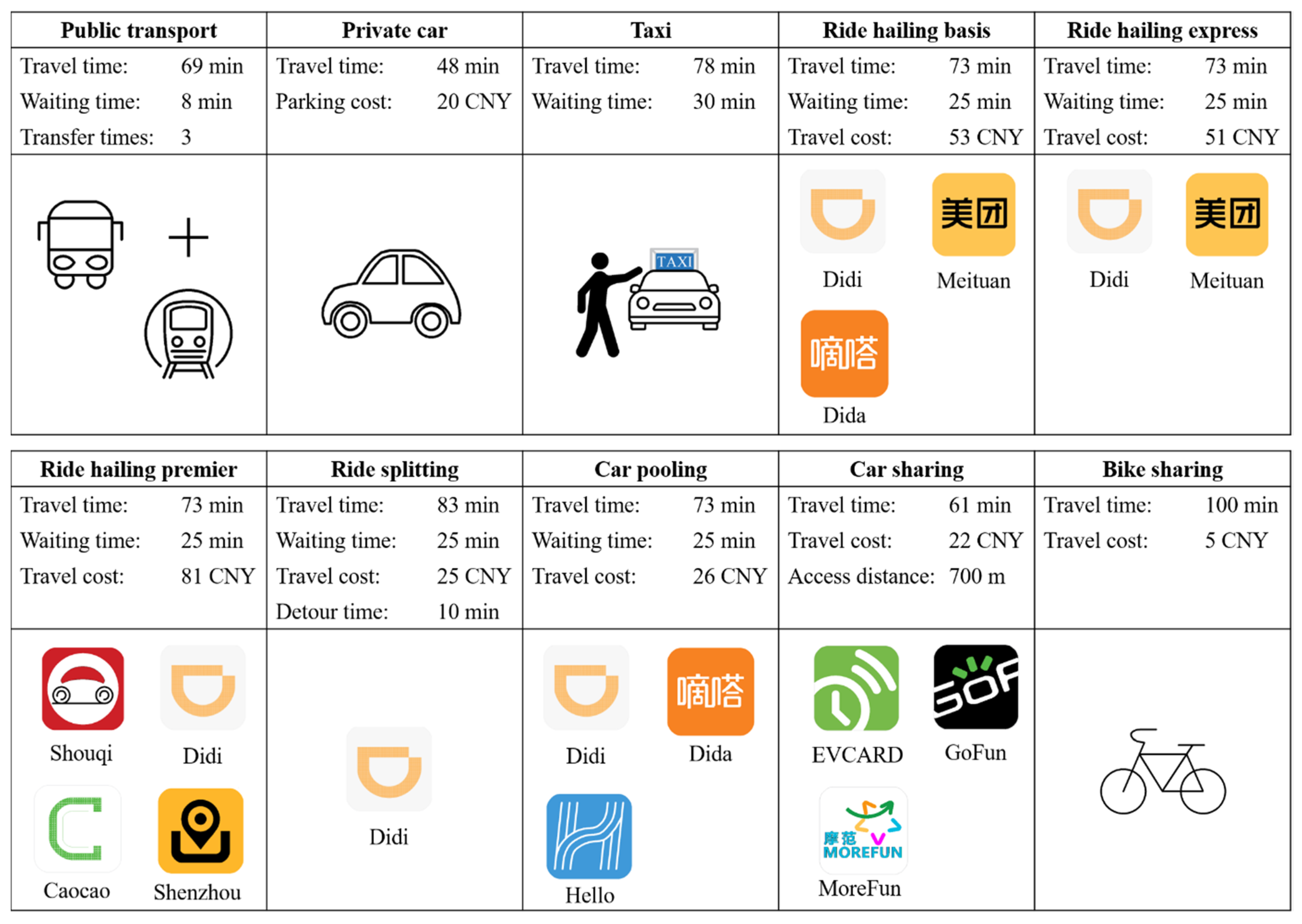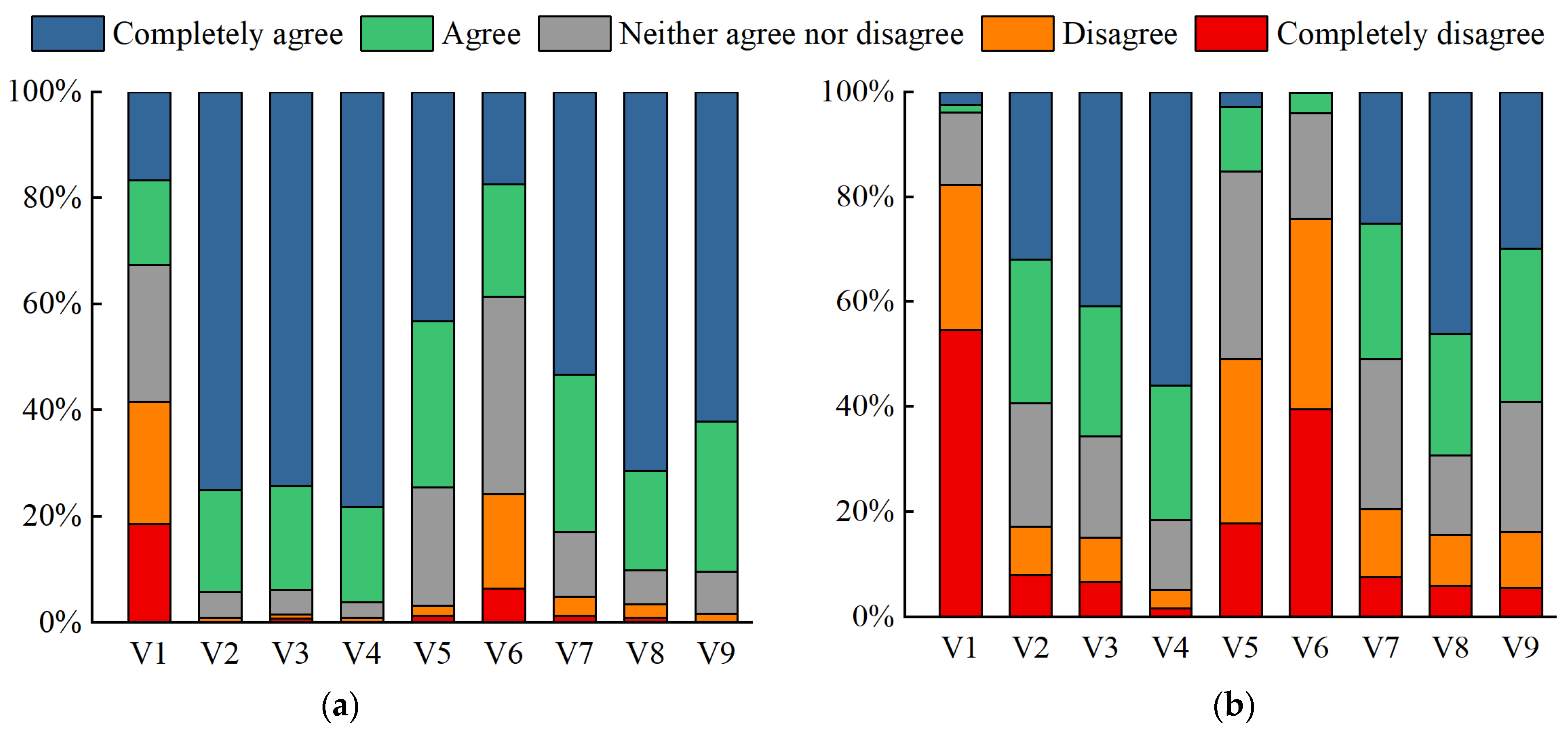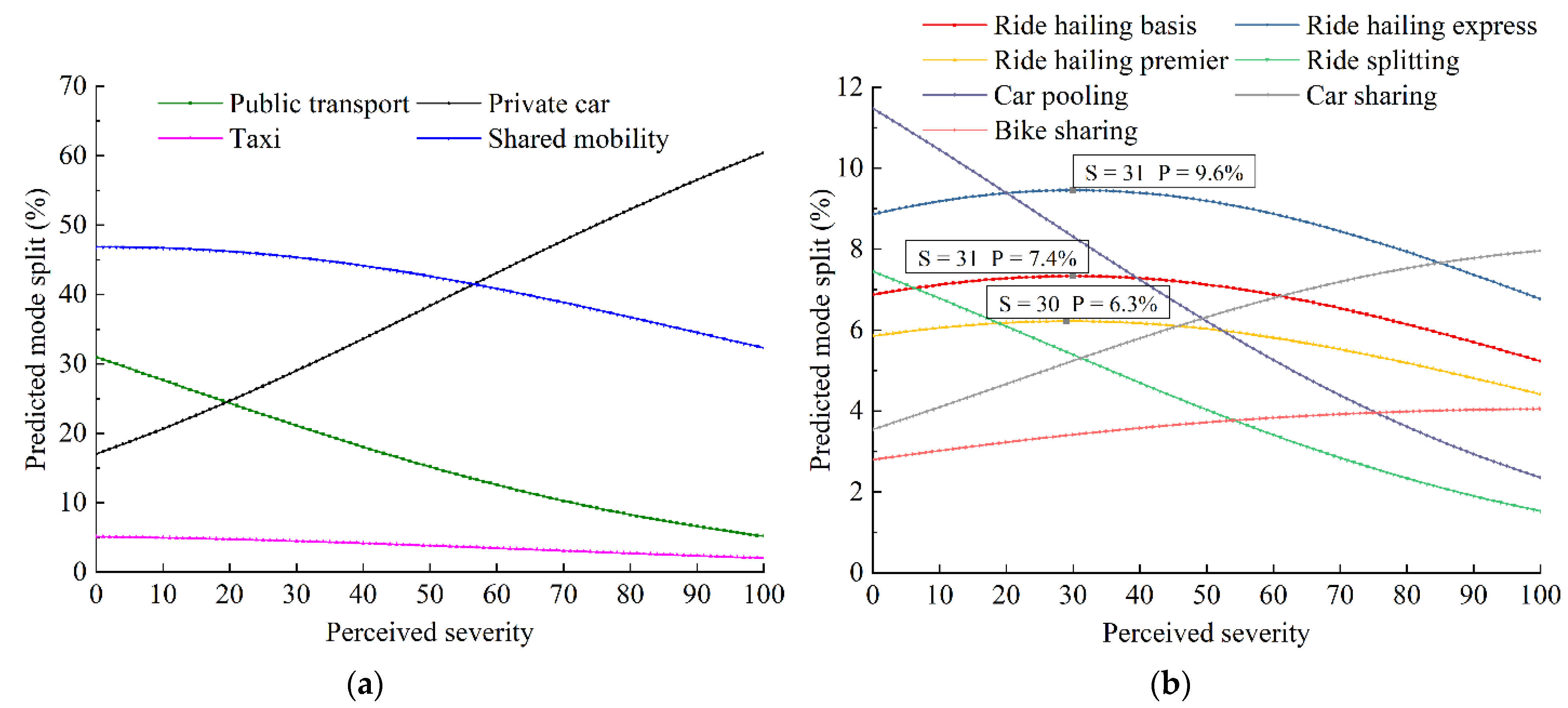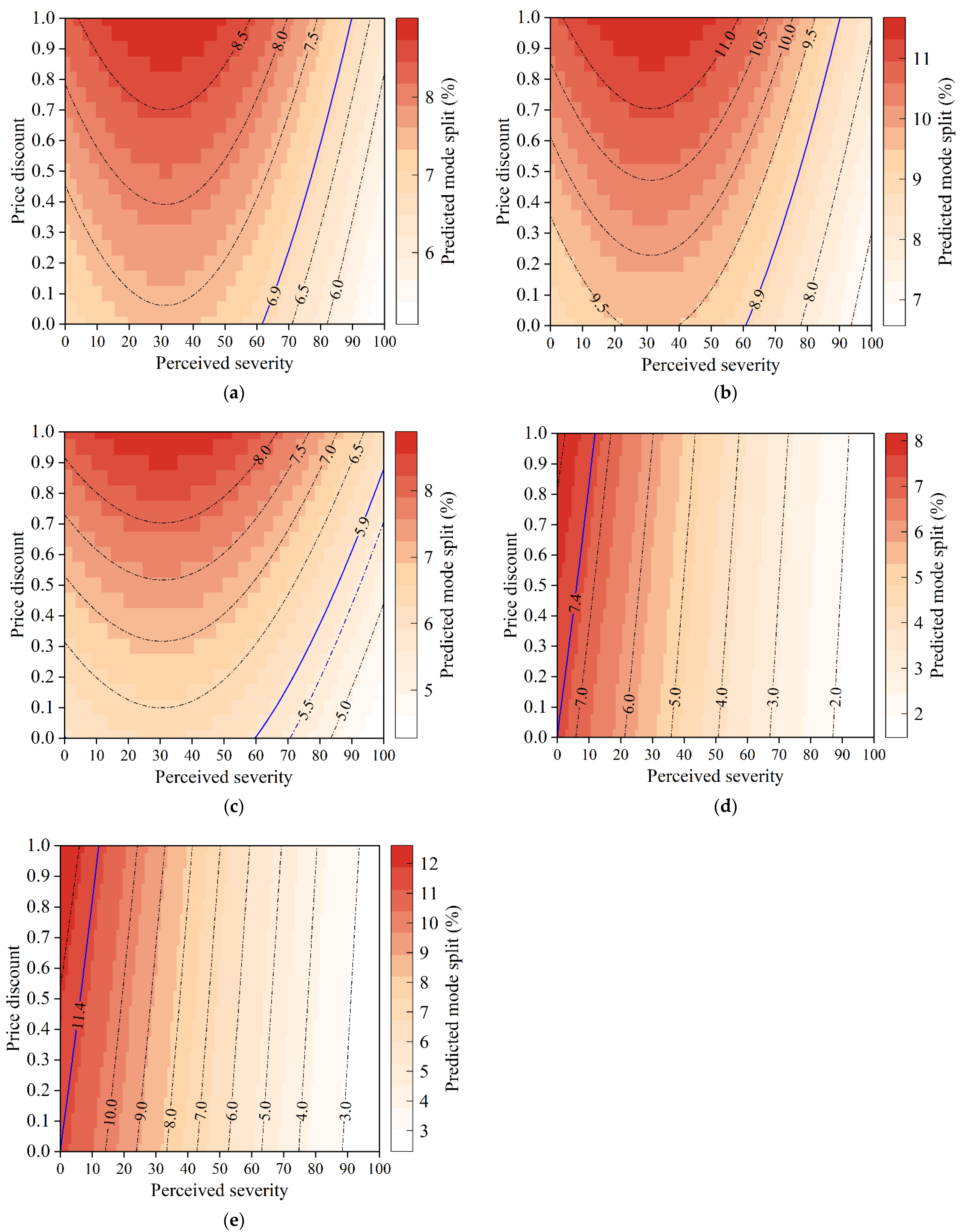The Impact of COVID-19 on Travel Mode Choice Behavior in Terms of Shared Mobility: A Case Study in Beijing, China
Abstract
:1. Introduction
2. Literature Review
2.1. Different Factors That Influence Shared Mobility Use
2.2. Travel Mode Choice Analysis during the COVID-19 Pandemic
3. Methodology
3.1. Research Framework
3.2. Survey and Data
3.2.1. Stated Preference Experiment Design
3.2.2. Participants
3.2.3. Attitudes toward Shared Mobility Services
3.3. Latent Class Analysis
3.4. Nested Logit Model
4. Results
4.1. Travel Mode Choice Distribution
4.2. Latent Class Analysis Results
4.3. Nested Logit Model Estimation Results
5. Discussion
5.1. Relationship between Perceived COVID-19 Severity and Travel Mode Choice
5.2. Relationship between COVID-19 Severity and Price Discount for Shared Mobility
6. Conclusions
Author Contributions
Funding
Data Availability Statement
Conflicts of Interest
References
- Xiong, Z.; Jian, L.; Wu, H. Understanding operation patterns of urban online ride-hailing services: A case study of Xiamen. Transp. Policy 2021, 101, 100–118. [Google Scholar] [CrossRef]
- Shen, H.; Zou, B.; Lin, J.; Liu, P. Modeling travel mode choice of young people with differentiated E-hailing ride services in Nanjing China. Transp. Res. Part D Transp. Environ. 2020, 78, 102216. [Google Scholar] [CrossRef]
- Alemi, F.; Circella, G.; Handy, S.; Mokhtarian, P. What influences travelers to use Uber? Exploring the factors affecting the adoption of on-demand ride services in California. Travel Behav. Soc. 2018, 13, 88–104. [Google Scholar] [CrossRef]
- Jiao, J.; Bischak, C.; Hyden, S. The impact of shared mobility on trip generation behavior in the US: Findings from the 2017 National Household Travel Survey. Travel Behav. Soc. 2020, 19, 1–7. [Google Scholar] [CrossRef]
- Wang, Z.; Chen, X.; Chen, X. Ridesplitting is shaping young people’s travel behavior: Evidence from comparative survey via ride-sourcing platform. Transp. Res. Part D Transp. Environ. 2019, 75, 57–71. [Google Scholar] [CrossRef]
- Li, W.; Pu, Z.; Li, Y.; Ban, X. Characterization of ridesplitting based on observed data: A case study of Chengdu, China. Transp. Res. Part C Emerg. Technol. 2019, 100, 330–353. [Google Scholar] [CrossRef]
- Jin, F.L.; An, K.; Yao, E.J. Mode choice analysis in urban transport with shared battery electric vehicles: A stated-preference case study in Beijing, China. Transp. Res. Part A Policy Pract. 2020, 133, 95–108. [Google Scholar] [CrossRef]
- Schimohr, K.; Scheiner, J. Spatial and temporal analysis of bike-sharing use in Cologne taking into account a public transit disruption. J. Transp. Geogr. 2021, 92, 103017. [Google Scholar] [CrossRef]
- World Health Organization. COVID-19 Weekly Epidemiological Update. 23 February 2021. Available online: https://www.who.int/publications/m/item/weekly-epidemiological-update---23-february-2021 (accessed on 15 November 2021).
- Loa, P.; Hossain, S.; Liu, Y.; Nurul Habib, K. How has the COVID-19 pandemic affected the use of ride-sourcing services? An empirical evidence-based investigation for the Greater Toronto Area. Transp. Res. Part A Policy Pract. 2022, 155, 46–62. [Google Scholar] [CrossRef]
- Rahimi, E.; Shabanpour, R.; Shamshiripour, A.; Mohammadian, A. Perceived risk of using shared mobility services during the COVID-19 pandemic. Transp. Res. Part F Traffic Psychol. Behav. 2021, 81, 271–281. [Google Scholar] [CrossRef]
- Jie, F.; Standing, C.; Biermann, S.; Standing, S.; Le, T. Factors affecting the adoption of shared mobility systems: Evidence from Australia. Res. Transp. Bus. Manag. 2021, 41, 100651. [Google Scholar] [CrossRef]
- Acheampong, R.A.; Siiba, A. Modelling the determinants of car-sharing adoption intentions among young adults: The role of attitude, perceived benefits, travel expectations and socio-demographic factors. Transportation 2019, 47, 2557–2580. [Google Scholar] [CrossRef] [Green Version]
- Si, H.; Duan, X.; Cheng, L.; Zhang, Z. Determinants of consumers’ continuance intention to use dynamic ride-sharing services. Transp. Res. Part D Transp. Environ. 2022, 104, 103201. [Google Scholar] [CrossRef]
- Liu, S.; Jiang, H.; Chen, Z. Quantifying the impact of weather on ride-hailing ridership: Evidence from Haikou, China. Travel Behav. Soc. 2021, 24, 257–269. [Google Scholar] [CrossRef]
- Taiebat, M.; Amini, E.; Xu, M. Sharing behavior in ride-hailing trips: A machine learning inference approach. Transp. Res. Part D Transp. Environ. 2022, 103, 103166. [Google Scholar] [CrossRef]
- Ho, C.Q.; Mulley, C.; Hensher, D.A. Public preferences for mobility as a service: Insights from stated preference surveys. Transp. Res. Part A Policy Pract. 2020, 131, 70–90. [Google Scholar] [CrossRef]
- Nikitas, A. Understanding bike-sharing acceptability and expected usage patterns in the context of a small city novel to the concept: A story of ‘Greek Drama’. Transp. Res. Part F Traffic Psychol. Behav. 2018, 56, 306–321. [Google Scholar] [CrossRef] [Green Version]
- Becker, H.; Loder, A.; Schmid, B.; Axhausen, K.W. Modeling car-sharing membership as a mobility tool: A multivariate Probit approach with latent variables. Travel Behav. Soc. 2017, 8, 26–36. [Google Scholar] [CrossRef] [Green Version]
- Bulteau, J.; Feuillet, T.; Dantan, S. Carpooling and carsharing for commuting in the Paris region: A comprehensive exploration of the individual and contextual correlates of their uses. Travel Behav. Soc. 2019, 16, 77–87. [Google Scholar] [CrossRef]
- Dias, F.F.; Lavieri, P.S.; Garikapati, V.M.; Astroza, S.; Pendyala, R.M.; Bhat, C.R. A behavioral choice model of the use of car-sharing and ride-sourcing services. Transportation 2017, 44, 1307–1323. [Google Scholar] [CrossRef]
- Eren, E.; Uz, V.E. A review on bike-sharing: The factors affecting bike-sharing demand. Sustain. Cities Soc. 2020, 54, 101882. [Google Scholar] [CrossRef]
- Gehrke, S.R.; Huff, M.P.; Reardon, T.G. Social and Trip-Level Predictors of Pooled Ride-Hailing Service Adoption in the Greater Boston Region. Case Stud. Transp. Policy 2021, 9, 1026–1034. [Google Scholar] [CrossRef]
- Tirachini, A.; del Río, M. Ride-hailing in Santiago de Chile: Users’ characterisation and effects on travel behaviour. Transp. Policy 2019, 82, 46–57. [Google Scholar] [CrossRef]
- Loa, P.; Nurul Habib, K. Examining the influence of attitudinal factors on the use of ride-hailing services in Toronto. Transp. Res. Part A Policy Pract. 2021, 146, 13–28. [Google Scholar] [CrossRef]
- Wang, Y.; Gu, J.; Wang, S.; Wang, J. Understanding consumers’ willingness to use ride-sharing services: The roles of perceived value and perceived risk. Transp. Res. Part C Emerg. Technol. 2019, 105, 504–519. [Google Scholar] [CrossRef]
- Hess, A.-K.; Schubert, I. Functional perceptions, barriers, and demographics concerning e-cargo bike sharing in Switzerland. Transp. Res. Part D Transp. Environ. 2019, 71, 153–168. [Google Scholar] [CrossRef]
- Thurner, T.; Fursov, K.; Nefedova, A. Early adopters of new transportation technologies: Attitudes of Russia’s population towards car sharing, the electric car and autonomous driving. Transp. Res. Part A Policy Pract. 2022, 155, 403–417. [Google Scholar] [CrossRef]
- Manca, F.; Sivakumar, A.; Polak, J.W. The effect of social influence and social interactions on the adoption of a new technology: The use of bike sharing in a student population. Transp. Res. Part C Emerg. Technol. 2019, 105, 611–625. [Google Scholar] [CrossRef]
- Picasso, E.; Postorino, M.N.; Bonoli-Escobar, M.; Stewart-Harris, M. Car-sharing vs bike-sharing: A choice experiment to understand young people behaviour. Transp. Policy 2020, 97, 121–128. [Google Scholar] [CrossRef]
- Papu Carrone, A.; Hoening, V.M.; Jensen, A.F.; Mabit, S.E.; Rich, J. Understanding car sharing preferences and mode substitution patterns: A stated preference experiment. Transp. Policy 2020, 98, 139–147. [Google Scholar] [CrossRef]
- Dowling, K.; Manchanda, P.; Spann, M. The existence and persistence of the pay-per-use bias in car sharing services. Int. J. Res. Mark. 2021, 38, 329–342. [Google Scholar] [CrossRef]
- Pinto, G.A.; Vieira, K.C.; Carvalho, E.G.; Sugano, J.Y. Applying the lazy user theory to understand the motivations for choosing carpooling over public transport. Sustain. Prod. Consum. 2019, 20, 243–252. [Google Scholar] [CrossRef]
- Liu, R.; Palm, M.; Shalaby, A.; Farber, S. A social equity lens on bus bridging and ride-hailing responses to unplanned subway disruptions. J. Transp. Geogr. 2020, 88, 102870. [Google Scholar] [CrossRef]
- Fu, X.-M. Does heavy ICT usage contribute to the adoption of ride-hailing app? Travel Behav. Soc. 2020, 21, 101–108. [Google Scholar] [CrossRef]
- Bayne, A.; Siegfried, A.; Beck, L.F.; Freund, K. Barriers and facilitators of older adults’ use of ride share services. J. Transp. Health 2021, 21, 101055. [Google Scholar] [CrossRef]
- Faghih-Imani, A.; Anowar, S.; Miller, E.J.; Eluru, N. Hail a cab or ride a bike? A travel time comparison of taxi and bicycle-sharing systems in New York City. Transp. Res. Part A Policy Pract. 2017, 101, 11–21. [Google Scholar] [CrossRef]
- Kutela, B.; Langa, N.; Mwende, S.; Kidando, E.; Kitali, A.E.; Bansal, P. A text mining approach to elicit public perception of bike-sharing systems. Travel Behav. Soc. 2021, 24, 113–123. [Google Scholar] [CrossRef]
- Kim, M.; Cho, G.-H. Analysis on bike-share ridership for origin-destination pairs: Effects of public transit route characteristics and land-use patterns. J. Transp. Geogr. 2021, 93, 103047. [Google Scholar] [CrossRef]
- Hu, S.H.; Chen, P. Who left riding transit? Examining socioeconomic disparities in the impact of COVID-19 on ridership. Transp. Res. Part D Transp. Environ. 2021, 90, 102654. [Google Scholar] [CrossRef]
- Dong, H.; Ma, S.; Jia, N.; Tian, J. Understanding public transport satisfaction in post COVID-19 pandemic. Transp. Policy 2021, 101, 81–88. [Google Scholar] [CrossRef]
- Das, S.; Boruah, A.; Banerjee, A.; Raoniar, R.; Nama, S.; Maurya, A.K. Impact of COVID-19: A radical modal shift from public to private transport mode. Transp. Policy 2021, 109, 1–11. [Google Scholar] [CrossRef]
- Basu, R.; Ferreira, J. Sustainable mobility in auto-dominated Metro Boston: Challenges and opportunities post-COVID-19. Transp. Policy 2021, 103, 197–210. [Google Scholar] [CrossRef]
- Eisenmann, C.; Nobis, C.; Kolarova, V.; Lenz, B.; Winkler, C. Transport mode use during the COVID-19 lockdown period in Germany: The car became more important, public transport lost ground. Transp. Policy 2021, 103, 60–67. [Google Scholar] [CrossRef]
- Shokouhyar, S.; Shokoohyar, S.; Sobhani, A.; Gorizi, A.J. Shared mobility in post-COVID era: New challenges and opportunities. Sustain. Cities Soc. 2021, 67, 102714. [Google Scholar] [CrossRef]
- Morshed, S.A.; Khan, S.S.; Tanvir, R.B.; Nur, S. Impact of COVID-19 pandemic on ride-hailing services based on large-scale Twitter data analysis. J. Urban Manag. 2021, 10, 155–165. [Google Scholar] [CrossRef]
- Luan, S.; Yang, Q.; Jiang, Z.; Wang, W. Exploring the impact of COVID-19 on individual’s travel mode choice in China. Transp. Policy 2021, 106, 271–280. [Google Scholar] [CrossRef]
- Curtale, R.; Liao, F.; van der Waerden, P. Understanding travel preferences for user-based relocation strategies of one-way electric car-sharing services. Transp. Res. Part C Emerg. Technol. 2021, 127, 103135. [Google Scholar] [CrossRef]
- Bergantino, A.S.; Intini, M.; Tangari, L. Influencing factors for potential bike-sharing users: An empirical analysis during the COVID-19 pandemic. Res. Transp. Econ. 2021, 86, 101028. [Google Scholar] [CrossRef]
- Hu, S.; Xiong, C.; Liu, Z.; Zhang, L. Examining spatiotemporal changing patterns of bike-sharing usage during COVID-19 pandemic. J. Transp. Geogr. 2021, 91, 102997. [Google Scholar] [CrossRef]
- Shang, H.-Y.; Huang, H.-J.; Wu, W.-X. Bus timetabling considering passenger satisfaction: An empirical study in Beijing. Comput. Ind. Eng. 2019, 135, 1155–1166. [Google Scholar] [CrossRef]
- Zhang, W.; Xia, D.; Liu, T.; Fu, Y.; Ma, J. Optimization of single-line bus timetables considering time-dependent travel times: A case study of Beijing, China. Comput. Ind. Eng. 2021, 158, 107444. [Google Scholar] [CrossRef]
- DiDi. Big Data Report on Smart Travel in North China; DiDi: Beijing, China, 2016. [Google Scholar]
- Beijing Municipal Commission of Development and Reform. Parking Charge Standard of Beijing. Available online: http://fgw.beijing.gov.cn/bmcx/djcx/cxldj/202003/t20200331_1752790.htm (accessed on 15 November 2021). (In Chinese)
- Beijing Municipal Health Commission. Epidemic Prevention and Control: All Communities in Beijing Have Become Low-Risk Areas; Beijing Municipal Health Commission: Beijing, China, 2020.
- Orme, B. Sample Size Issues for Conjoint Analysis studies. In Sawthooth Software Research Paper Series Squim; Sawthooth Software Inc.: Sequim, WA, USA, 1998. [Google Scholar]
- Lancsar, E.; Louviere, J. Conducting discrete choice experiments to inform healthcare decision making. Pharmacoeconomics 2008, 26, 661–677. [Google Scholar] [CrossRef] [PubMed]
- Beijing Municipal Bureau Statistics. Beijing Statistical Yearbook. 2020. Available online: http://nj.tjj.beijing.gov.cn/nj/main/2020-tjnj/zk/indexch.htm (accessed on 15 November 2021).
- Shi, K.; Shao, R.; De Vos, J.; Cheng, L.; Witlox, F. The influence of ride-hailing on travel frequency and mode choice. Transp. Res. Part D Transp. Environ. 2021, 101, 103125. [Google Scholar] [CrossRef]
- Shen, Y.; Ta, N.; Chai, Y. The Internet and the space–time flexibility of daily activities: A case study of Beijing, China. Cities 2020, 97, 102493. [Google Scholar] [CrossRef]
- Yang, Y.; He, K.; Wang, Y.; Yuan, Z.; Yin, Y.; Guo, M. Identification of dynamic traffic crash risk for cross-area freeways based on statistical and machine learning methods. Phys. A Stat. Mech. Its Appl. 2022, 595, 127083. [Google Scholar] [CrossRef]
- Yang, Y.; Yuan, Z.; Chen, J.; Guo, M. Assessment of osculating value method based on entropy weight to transportation energy conservation and emission reduction. Environ. Eng. Manag. J. 2017, 16, 2413–2423. [Google Scholar] [CrossRef]
- Cronbach, L.J. Coefficient alpha and the internal structure of tests. Psychometrika 1951, 16, 297–334. [Google Scholar] [CrossRef] [Green Version]
- Hair, J.F.; Black, W.C.; Babin, B.J.; Anderson, R.E. Multivariate Data Analysis: Pearson College Division; Person: London, UK, 2010. [Google Scholar]
- Collins, L.M.; Lanza, S.T. Latent Class and Latent Transition Analysis: With Applications in the Social, Behavioral, and Health Sciences; Wiley: Hoboken, NJ, USA, 2009. [Google Scholar]
- Train, K. Discrete Choice Methods with Simulation; Cambridge University Press: Cambridge, UK, 2003. [Google Scholar]








| Factor | Ride Hailing | Ride Sharing | Car Sharing | Bike Sharing | Source |
|---|---|---|---|---|---|
| Male | - | - | + | + | [3,12,13] |
| Age | - | + | - | + | [17,18,19,20] |
| Income | + | - | + | + | [21,22,23] |
| Education | + | - | + | + | [2,20,22,23] |
| Car ownership | - | - | - | + | [7,22,23,24] |
| Security risk | - | - | - | - | [25,26,27,28] |
| Environmental awareness | + | + | + | + | [3,14,29,30] |
| Bad weather | + | + | + | - | [15,31,32,33] |
| Non-commuting | - | + | + | - | [2,5,7,8] |
| Travel time | - | - | - | - | [2,7,20,31] |
| Travel cost | - | - | - | - | [2,7,16,31] |
| Variable | Description | Percentage (%) | The Whole Population of Beijing (%) | Perceived COVID-19 Severity |
|---|---|---|---|---|
| Gender | Male | 52.63 | 51.63 | 72.2 |
| Female | 47.37 | 48.37 | 72.04 | |
| Age (years) | 18–29 | 37.64 | 20.21 | 68.09 |
| 30–39 | 36.54 | 23.9 | 73.14 | |
| 40–49 | 19.36 | 18.49 | 76.25 | |
| ≥50 | 6.46 | 37.4 | 79.02 | |
| School-age children | Have 7-to-11-year-old children | 14.9 | – | 71.39 |
| No 7-to-11-year-old child | 85.1 | – | 76.31 | |
| Car ownership | One or more cars | 63.36 | 54 | 62.45 |
| No car | 36.64 | 46 | 77.71 |
| NO. | Statements | Mean | SD |
|---|---|---|---|
| V1 | I would like to choose departure time and travel routes flexibly. | 4.526 | 0.801 |
| V2 | I am familiar with using smartphone apps to manage my trip. | 4.265 | 1.082 |
| V3 | Shared mobility could alleviate the traffic congestion. | 4.264 | 1.067 |
| V4 | I prefer to use shared mobility in the cases of parking difficulty and high parking fees. | 4.186 | 1.095 |
| V5 | I can easily afford travel costs of shared mobility. | 4.102 | 1.049 |
| V6 | I would like to take initiative to discover and try something new. | 3.903 | 1.142 |
| V7 | I think shared mobility travel is more convenient than driving. | 3.345 | 1.259 |
| V8 | I think shared mobility travel is more comfortable than driving. | 2.592 | 1.221 |
| V9 | I think shared mobility travel is safer than driving. | 2.311 | 1.304 |
| Number of Classes | Log Likelihood | AIC | BIC | p-Value | Group Size |
|---|---|---|---|---|---|
| 2 | −12,588.489 | 25,292.979 | 25,578.033 | 0.000 | 578/429 |
| 3 | −12,767.084 | 25,630.168 | 25,866.076 | 0.000 | 158/548/301 |
| 4 | −12,936.093 | 25,948.186 | 26,134.946 | 0.000 | 546/105/80/276 |
| 5 | −13,158.101 | 26,372.203 | 26,509.815 | 0.000 | 24/86/169/254/474 |
| Variable | Before COVID-19 | During COVID-19 | Variable | Before COVID-19 | During COVID-19 | ||||
|---|---|---|---|---|---|---|---|---|---|
| Estimates | p-Value | Estimates | p-Value | Estimates | p-Value | Estimates | p-Value | ||
| Lower level | Constant | ||||||||
| Mode-specific variables | Public transport | 2.860 | *** | 2.080 | *** | ||||
| Waiting time | −0.013 | *** | −0.025 | *** | Private car | 1.620 | *** | 0.837 | ** |
| Transfer times | −0.084 | *** | −0.102 | * | Taxi (reference) | 0 | 0 | ||
| Parking cost | −0.014 | * | −0.019 | *** | Ride hailing basis | 0.401 | −0.489 | ||
| Detour time | −0.016 | * | −0.011 | Ride hailing express | 0.863 | ** | −0.220 | ||
| Access distance | −0.480 | *** | −0.452 | *** | Ride hailing premier | −0.178 | −0.643 | ||
| Travel cost | −0.006 | *** | −0.004 | *** | Ride splitting | 0.727 | 0.256 | ||
| Perceived safety | 0.008 | *** | 0.009 | *** | Car pooling | 0.817 | ** | 0.432 | |
| Perceived comfort | 0.001 | 0.003 | ** | Car sharing | 0.478 | −0.909 | * | ||
| Bike sharing | 3.130 | *** | 2.070 | *** | |||||
| Upper level | |||||||||
| School-age children (base: No 7-to-11-year-old child) | Shared-mobility optimists (base: shared-mobility pessimists) | ||||||||
| Public transport | −0.906 | *** | −0.206 | Public transport | 0.068 | −0.271 | |||
| Private car | −0.417 | −0.141 | Private car | −0.508 | ** | −0.489 | ** | ||
| Taxi (reference) | 0 | 0 | Taxi (reference) | 0 | 0 | ||||
| Ride hailing | −0.565 | * | 0.052 | Ride hailing | 0.186 | −0.106 | |||
| Ride sharing | −0.729 | ** | −0.069 | Ride sharing | 0.402 | * | −0.526 | ** | |
| Car sharing | −0.420 | 0.083 | Car sharing | 0.244 | 0.333 | ||||
| Bike sharing | −1.070 | ** | −0.183 | Bike sharing | −0.165 | −0.314 | |||
| Car ownership (base: no car) | Perceived COVID-19 severity | ||||||||
| Public transport | −0.130 | 0.218 | Public transport | – | – | −0.008 | * | ||
| Private car | 0.730 | *** | 1.010 | *** | Private car | – | – | 0.023 | *** |
| Taxi (reference) | 0 | 0 | Taxi (reference) | – | – | 0 | |||
| Ride hailing | −0.050 | 0.416 | * | Ride hailing | – | – | 0.007 | ||
| Ride sharing | 0.045 | 0.748 | *** | Ride sharing | – | – | −0.005 | * | |
| Car sharing | 0.131 | 0.396 | Car sharing | – | – | 0.019 | *** | ||
| Bike sharing | −0.799 | ** | −0.061 | Bike sharing | – | – | 0.015 | ** | |
| Transportation terminal access (base: not this trip purpose) | Confirmed cases | ||||||||
| Public transport | −0.504 | ** | −0.642 | ** | Public transport | – | – | 0.001 | |
| Private car | −0.621 | ** | −0.866 | *** | Private car | – | – | 0.003 | * |
| Taxi (reference) | 0 | 0 | Taxi (reference) | – | – | 0 | |||
| Ride hailing | −0.053 | −0.241 | Ride hailing | – | – | 0.002 | |||
| Ride sharing | −0.295 | −0.279 | Ride sharing | – | – | 0.002 | |||
| Car sharing | −0.388 | −0.532 | ** | Car sharing | – | – | 0.003 | ||
| Bike sharing | −0.389 | −1.250 | *** | Bike sharing | – | – | 0.002 | ||
| Scale parameter | |||||||||
| 0.714 | *** | 0.613 | *** | Log likelihood | −5018.882 | −4736.341 | |||
| 0.699 | ** | 0.606 | ** | 0.267 | 0.301 | ||||
| Sample size | 3021 | 3021 | |||||||
Publisher’s Note: MDPI stays neutral with regard to jurisdictional claims in published maps and institutional affiliations. |
© 2022 by the authors. Licensee MDPI, Basel, Switzerland. This article is an open access article distributed under the terms and conditions of the Creative Commons Attribution (CC BY) license (https://creativecommons.org/licenses/by/4.0/).
Share and Cite
Zhang, X.; Shao, C.; Wang, B.; Huang, S. The Impact of COVID-19 on Travel Mode Choice Behavior in Terms of Shared Mobility: A Case Study in Beijing, China. Int. J. Environ. Res. Public Health 2022, 19, 7130. https://doi.org/10.3390/ijerph19127130
Zhang X, Shao C, Wang B, Huang S. The Impact of COVID-19 on Travel Mode Choice Behavior in Terms of Shared Mobility: A Case Study in Beijing, China. International Journal of Environmental Research and Public Health. 2022; 19(12):7130. https://doi.org/10.3390/ijerph19127130
Chicago/Turabian StyleZhang, Xiaoyu, Chunfu Shao, Bobin Wang, and Shichen Huang. 2022. "The Impact of COVID-19 on Travel Mode Choice Behavior in Terms of Shared Mobility: A Case Study in Beijing, China" International Journal of Environmental Research and Public Health 19, no. 12: 7130. https://doi.org/10.3390/ijerph19127130
APA StyleZhang, X., Shao, C., Wang, B., & Huang, S. (2022). The Impact of COVID-19 on Travel Mode Choice Behavior in Terms of Shared Mobility: A Case Study in Beijing, China. International Journal of Environmental Research and Public Health, 19(12), 7130. https://doi.org/10.3390/ijerph19127130






